Management Accounting Report: Cost Analysis, Budgeting, and Variance
VerifiedAdded on 2020/01/28
|18
|5067
|40
Report
AI Summary
This report delves into management accounting principles, focusing on a case study of Jeffrey & Son's. It begins with cost classification, including direct, indirect, fixed, and variable costs, and then moves on to determining unit costs using job costing and absorption costing methods. The report covers overhead allocation using both machine hour and labor hour bases, followed by a cost report analysis that examines variances in material, labor, and overhead costs. Performance indicators, such as revenue, product quality, and profitability, are discussed to identify areas for improvement. The report also explores cost reduction strategies, product quality enhancement, and value creation. Furthermore, it examines budgeting processes, including production, material purchase, and cash budgets. Finally, it addresses variance analysis, identifies possible causes, and recommends corrective actions, concluding with a discussion of responsibility centers and their roles in financial management.
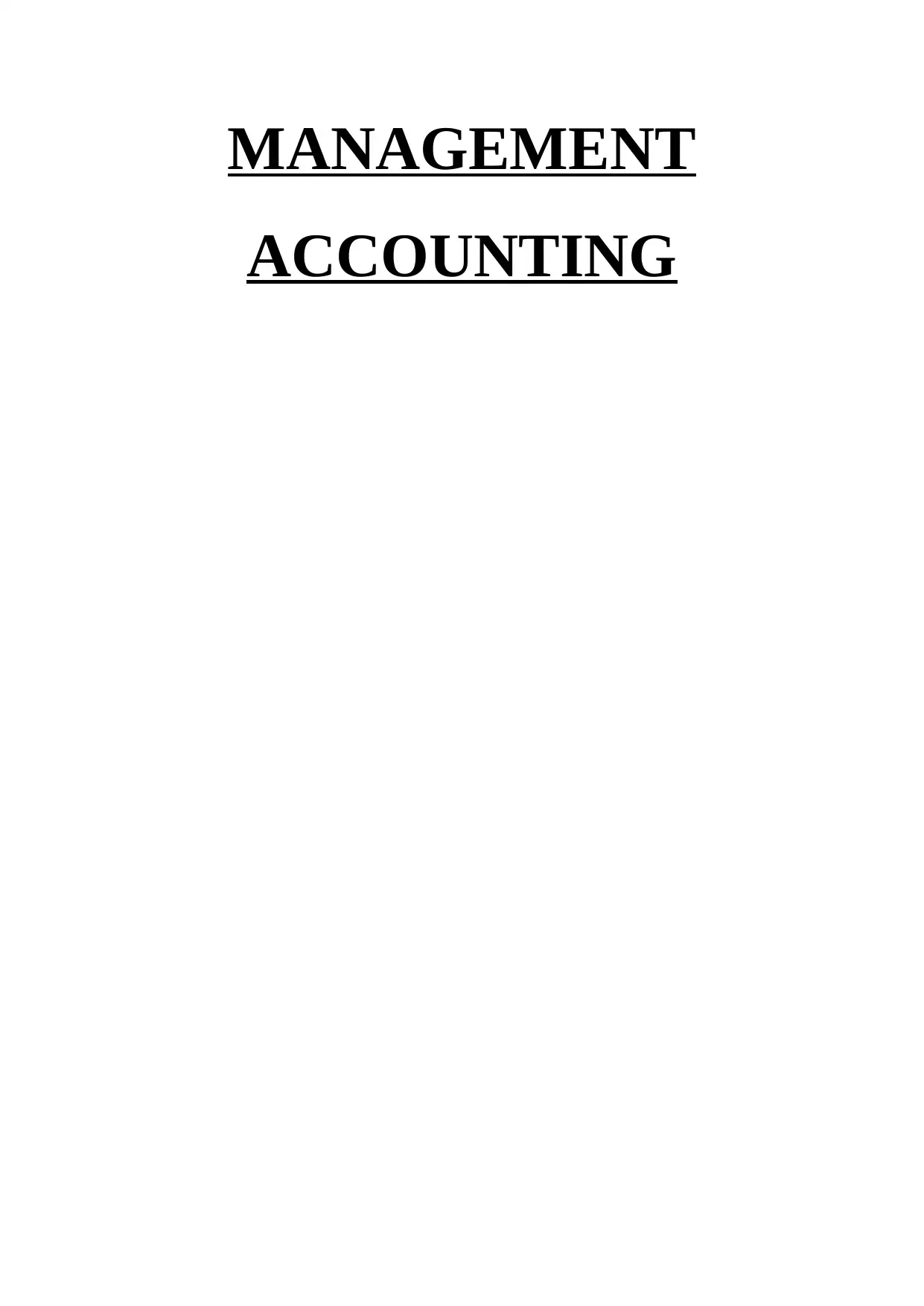
MANAGEMENT
ACCOUNTING
ACCOUNTING
Paraphrase This Document
Need a fresh take? Get an instant paraphrase of this document with our AI Paraphraser
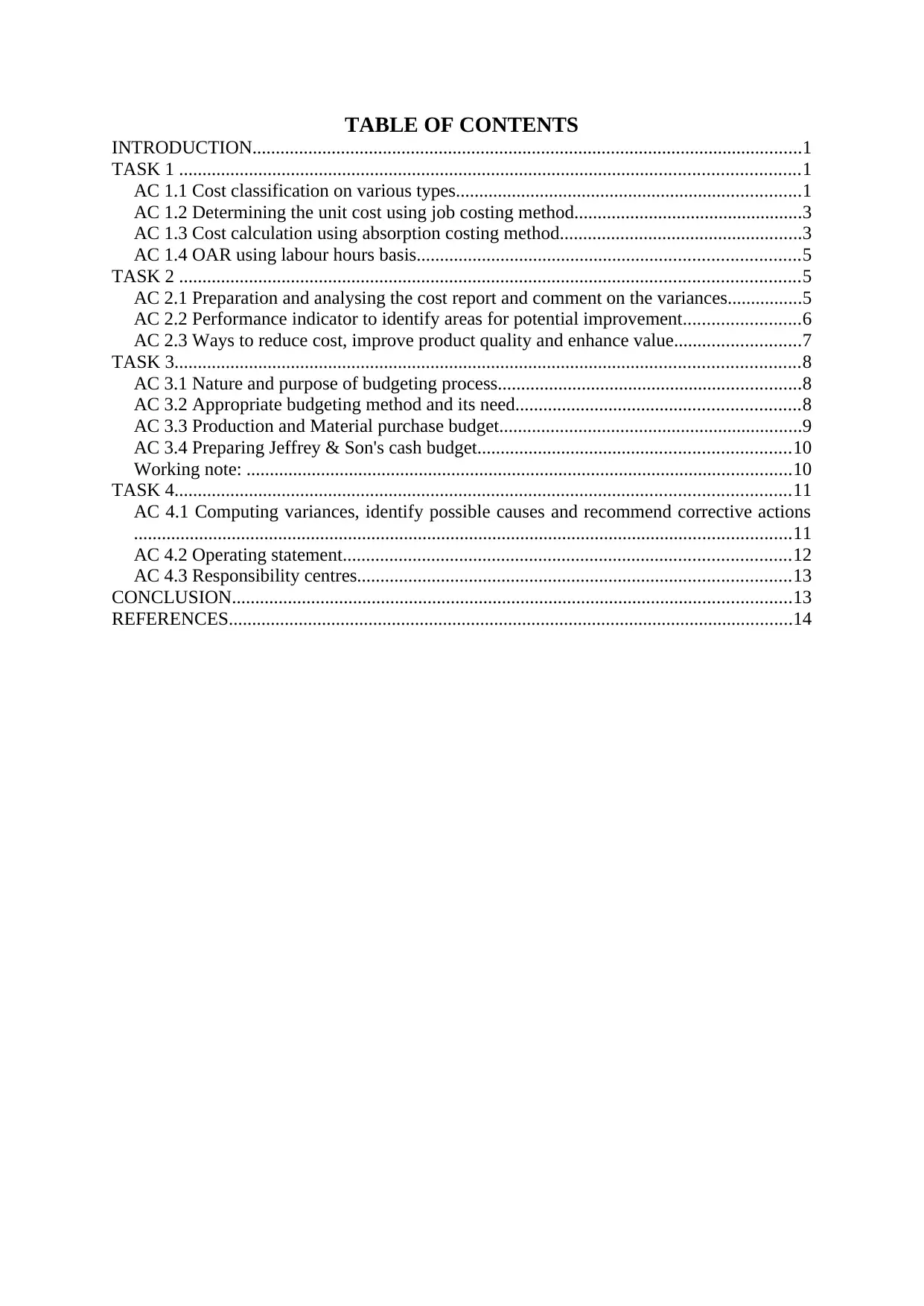
TABLE OF CONTENTS
INTRODUCTION......................................................................................................................1
TASK 1 .....................................................................................................................................1
AC 1.1 Cost classification on various types..........................................................................1
AC 1.2 Determining the unit cost using job costing method.................................................3
AC 1.3 Cost calculation using absorption costing method....................................................3
AC 1.4 OAR using labour hours basis..................................................................................5
TASK 2 .....................................................................................................................................5
AC 2.1 Preparation and analysing the cost report and comment on the variances................5
AC 2.2 Performance indicator to identify areas for potential improvement.........................6
AC 2.3 Ways to reduce cost, improve product quality and enhance value...........................7
TASK 3......................................................................................................................................8
AC 3.1 Nature and purpose of budgeting process.................................................................8
AC 3.2 Appropriate budgeting method and its need.............................................................8
AC 3.3 Production and Material purchase budget.................................................................9
AC 3.4 Preparing Jeffrey & Son's cash budget...................................................................10
Working note: .....................................................................................................................10
TASK 4....................................................................................................................................11
AC 4.1 Computing variances, identify possible causes and recommend corrective actions
.............................................................................................................................................11
AC 4.2 Operating statement................................................................................................12
AC 4.3 Responsibility centres.............................................................................................13
CONCLUSION........................................................................................................................13
REFERENCES.........................................................................................................................14
INTRODUCTION......................................................................................................................1
TASK 1 .....................................................................................................................................1
AC 1.1 Cost classification on various types..........................................................................1
AC 1.2 Determining the unit cost using job costing method.................................................3
AC 1.3 Cost calculation using absorption costing method....................................................3
AC 1.4 OAR using labour hours basis..................................................................................5
TASK 2 .....................................................................................................................................5
AC 2.1 Preparation and analysing the cost report and comment on the variances................5
AC 2.2 Performance indicator to identify areas for potential improvement.........................6
AC 2.3 Ways to reduce cost, improve product quality and enhance value...........................7
TASK 3......................................................................................................................................8
AC 3.1 Nature and purpose of budgeting process.................................................................8
AC 3.2 Appropriate budgeting method and its need.............................................................8
AC 3.3 Production and Material purchase budget.................................................................9
AC 3.4 Preparing Jeffrey & Son's cash budget...................................................................10
Working note: .....................................................................................................................10
TASK 4....................................................................................................................................11
AC 4.1 Computing variances, identify possible causes and recommend corrective actions
.............................................................................................................................................11
AC 4.2 Operating statement................................................................................................12
AC 4.3 Responsibility centres.............................................................................................13
CONCLUSION........................................................................................................................13
REFERENCES.........................................................................................................................14
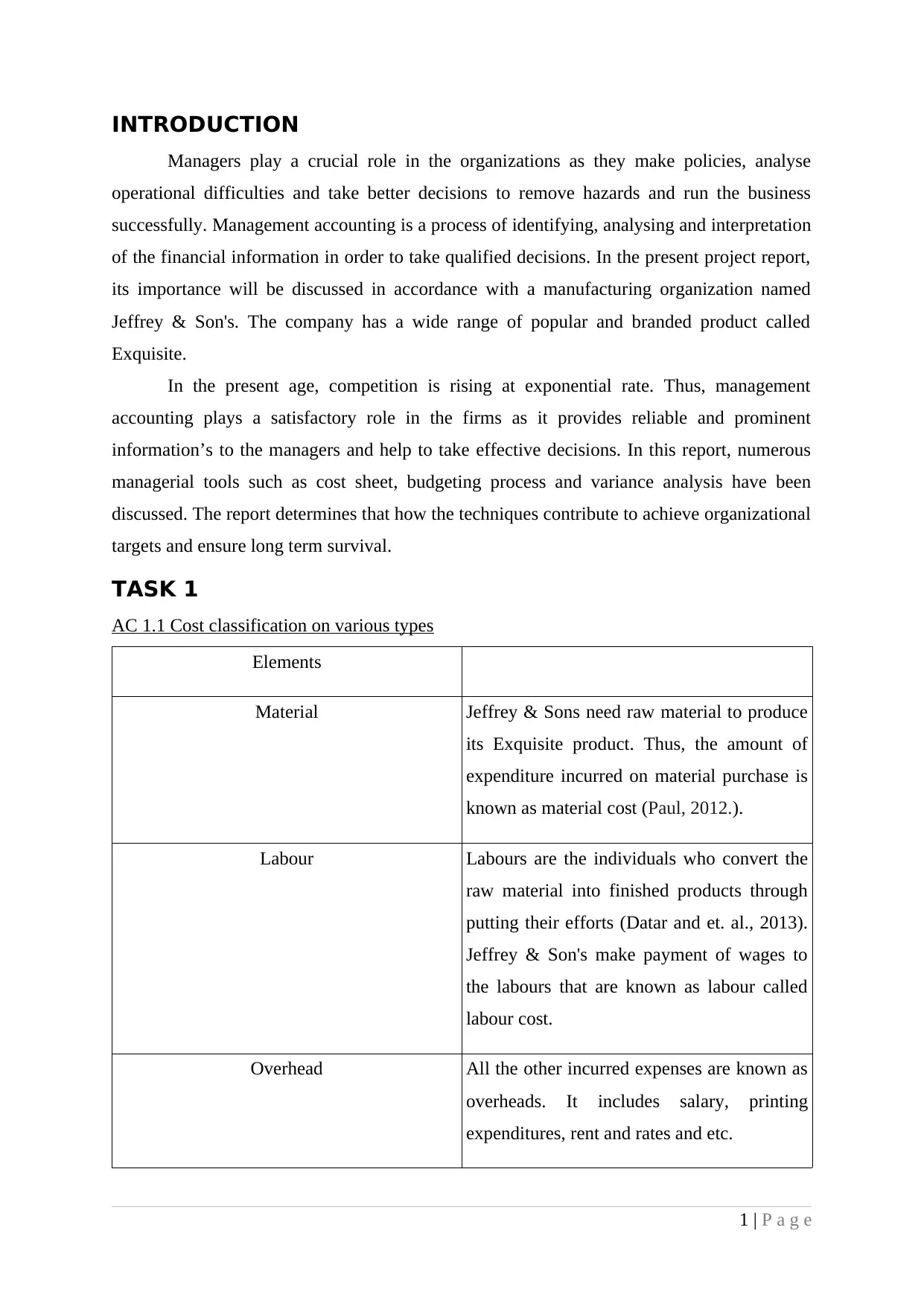
INTRODUCTION
Managers play a crucial role in the organizations as they make policies, analyse
operational difficulties and take better decisions to remove hazards and run the business
successfully. Management accounting is a process of identifying, analysing and interpretation
of the financial information in order to take qualified decisions. In the present project report,
its importance will be discussed in accordance with a manufacturing organization named
Jeffrey & Son's. The company has a wide range of popular and branded product called
Exquisite.
In the present age, competition is rising at exponential rate. Thus, management
accounting plays a satisfactory role in the firms as it provides reliable and prominent
information’s to the managers and help to take effective decisions. In this report, numerous
managerial tools such as cost sheet, budgeting process and variance analysis have been
discussed. The report determines that how the techniques contribute to achieve organizational
targets and ensure long term survival.
TASK 1
AC 1.1 Cost classification on various types
Elements
Material Jeffrey & Sons need raw material to produce
its Exquisite product. Thus, the amount of
expenditure incurred on material purchase is
known as material cost (Paul, 2012.).
Labour Labours are the individuals who convert the
raw material into finished products through
putting their efforts (Datar and et. al., 2013).
Jeffrey & Son's make payment of wages to
the labours that are known as labour called
labour cost.
Overhead All the other incurred expenses are known as
overheads. It includes salary, printing
expenditures, rent and rates and etc.
1 | P a g e
Managers play a crucial role in the organizations as they make policies, analyse
operational difficulties and take better decisions to remove hazards and run the business
successfully. Management accounting is a process of identifying, analysing and interpretation
of the financial information in order to take qualified decisions. In the present project report,
its importance will be discussed in accordance with a manufacturing organization named
Jeffrey & Son's. The company has a wide range of popular and branded product called
Exquisite.
In the present age, competition is rising at exponential rate. Thus, management
accounting plays a satisfactory role in the firms as it provides reliable and prominent
information’s to the managers and help to take effective decisions. In this report, numerous
managerial tools such as cost sheet, budgeting process and variance analysis have been
discussed. The report determines that how the techniques contribute to achieve organizational
targets and ensure long term survival.
TASK 1
AC 1.1 Cost classification on various types
Elements
Material Jeffrey & Sons need raw material to produce
its Exquisite product. Thus, the amount of
expenditure incurred on material purchase is
known as material cost (Paul, 2012.).
Labour Labours are the individuals who convert the
raw material into finished products through
putting their efforts (Datar and et. al., 2013).
Jeffrey & Son's make payment of wages to
the labours that are known as labour called
labour cost.
Overhead All the other incurred expenses are known as
overheads. It includes salary, printing
expenditures, rent and rates and etc.
1 | P a g e
⊘ This is a preview!⊘
Do you want full access?
Subscribe today to unlock all pages.

Trusted by 1+ million students worldwide
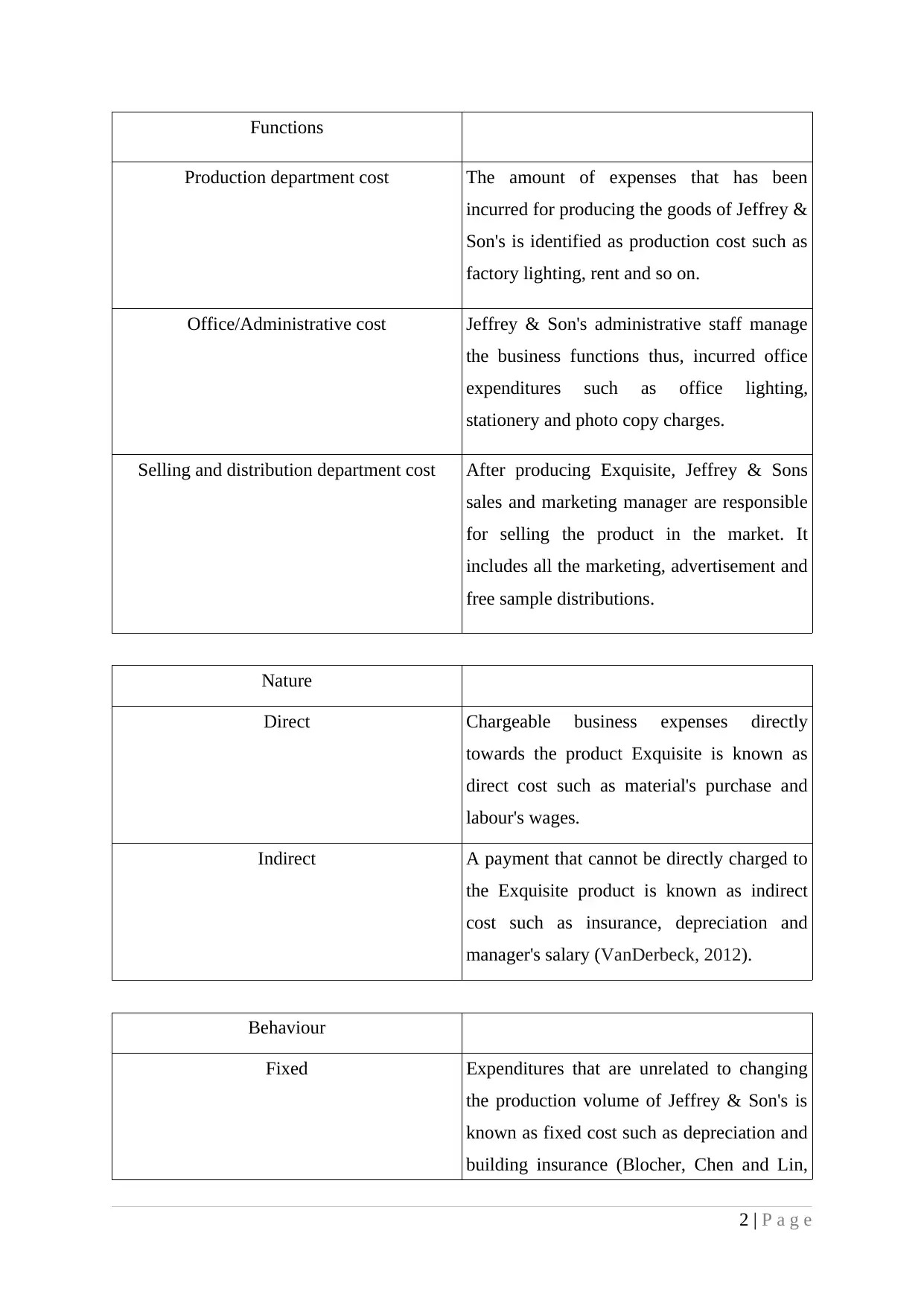
Functions
Production department cost The amount of expenses that has been
incurred for producing the goods of Jeffrey &
Son's is identified as production cost such as
factory lighting, rent and so on.
Office/Administrative cost Jeffrey & Son's administrative staff manage
the business functions thus, incurred office
expenditures such as office lighting,
stationery and photo copy charges.
Selling and distribution department cost After producing Exquisite, Jeffrey & Sons
sales and marketing manager are responsible
for selling the product in the market. It
includes all the marketing, advertisement and
free sample distributions.
Nature
Direct Chargeable business expenses directly
towards the product Exquisite is known as
direct cost such as material's purchase and
labour's wages.
Indirect A payment that cannot be directly charged to
the Exquisite product is known as indirect
cost such as insurance, depreciation and
manager's salary (VanDerbeck, 2012).
Behaviour
Fixed Expenditures that are unrelated to changing
the production volume of Jeffrey & Son's is
known as fixed cost such as depreciation and
building insurance (Blocher, Chen and Lin,
2 | P a g e
Production department cost The amount of expenses that has been
incurred for producing the goods of Jeffrey &
Son's is identified as production cost such as
factory lighting, rent and so on.
Office/Administrative cost Jeffrey & Son's administrative staff manage
the business functions thus, incurred office
expenditures such as office lighting,
stationery and photo copy charges.
Selling and distribution department cost After producing Exquisite, Jeffrey & Sons
sales and marketing manager are responsible
for selling the product in the market. It
includes all the marketing, advertisement and
free sample distributions.
Nature
Direct Chargeable business expenses directly
towards the product Exquisite is known as
direct cost such as material's purchase and
labour's wages.
Indirect A payment that cannot be directly charged to
the Exquisite product is known as indirect
cost such as insurance, depreciation and
manager's salary (VanDerbeck, 2012).
Behaviour
Fixed Expenditures that are unrelated to changing
the production volume of Jeffrey & Son's is
known as fixed cost such as depreciation and
building insurance (Blocher, Chen and Lin,
2 | P a g e
Paraphrase This Document
Need a fresh take? Get an instant paraphrase of this document with our AI Paraphraser
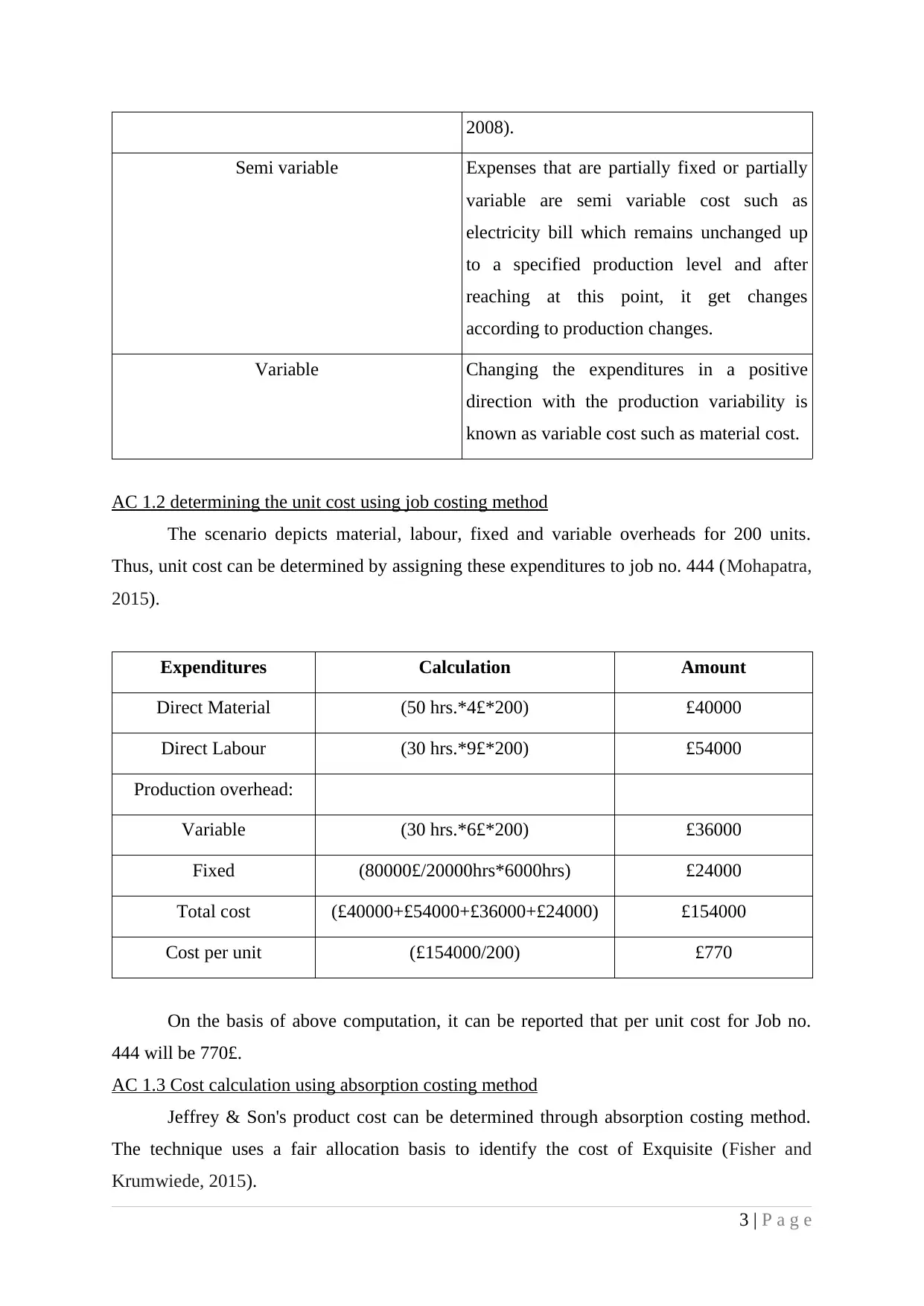
2008).
Semi variable Expenses that are partially fixed or partially
variable are semi variable cost such as
electricity bill which remains unchanged up
to a specified production level and after
reaching at this point, it get changes
according to production changes.
Variable Changing the expenditures in a positive
direction with the production variability is
known as variable cost such as material cost.
AC 1.2 determining the unit cost using job costing method
The scenario depicts material, labour, fixed and variable overheads for 200 units.
Thus, unit cost can be determined by assigning these expenditures to job no. 444 (Mohapatra,
2015).
Expenditures Calculation Amount
Direct Material (50 hrs.*4£*200) £40000
Direct Labour (30 hrs.*9£*200) £54000
Production overhead:
Variable (30 hrs.*6£*200) £36000
Fixed (80000£/20000hrs*6000hrs) £24000
Total cost (£40000+£54000+£36000+£24000) £154000
Cost per unit (£154000/200) £770
On the basis of above computation, it can be reported that per unit cost for Job no.
444 will be 770£.
AC 1.3 Cost calculation using absorption costing method
Jeffrey & Son's product cost can be determined through absorption costing method.
The technique uses a fair allocation basis to identify the cost of Exquisite (Fisher and
Krumwiede, 2015).
3 | P a g e
Semi variable Expenses that are partially fixed or partially
variable are semi variable cost such as
electricity bill which remains unchanged up
to a specified production level and after
reaching at this point, it get changes
according to production changes.
Variable Changing the expenditures in a positive
direction with the production variability is
known as variable cost such as material cost.
AC 1.2 determining the unit cost using job costing method
The scenario depicts material, labour, fixed and variable overheads for 200 units.
Thus, unit cost can be determined by assigning these expenditures to job no. 444 (Mohapatra,
2015).
Expenditures Calculation Amount
Direct Material (50 hrs.*4£*200) £40000
Direct Labour (30 hrs.*9£*200) £54000
Production overhead:
Variable (30 hrs.*6£*200) £36000
Fixed (80000£/20000hrs*6000hrs) £24000
Total cost (£40000+£54000+£36000+£24000) £154000
Cost per unit (£154000/200) £770
On the basis of above computation, it can be reported that per unit cost for Job no.
444 will be 770£.
AC 1.3 Cost calculation using absorption costing method
Jeffrey & Son's product cost can be determined through absorption costing method.
The technique uses a fair allocation basis to identify the cost of Exquisite (Fisher and
Krumwiede, 2015).
3 | P a g e
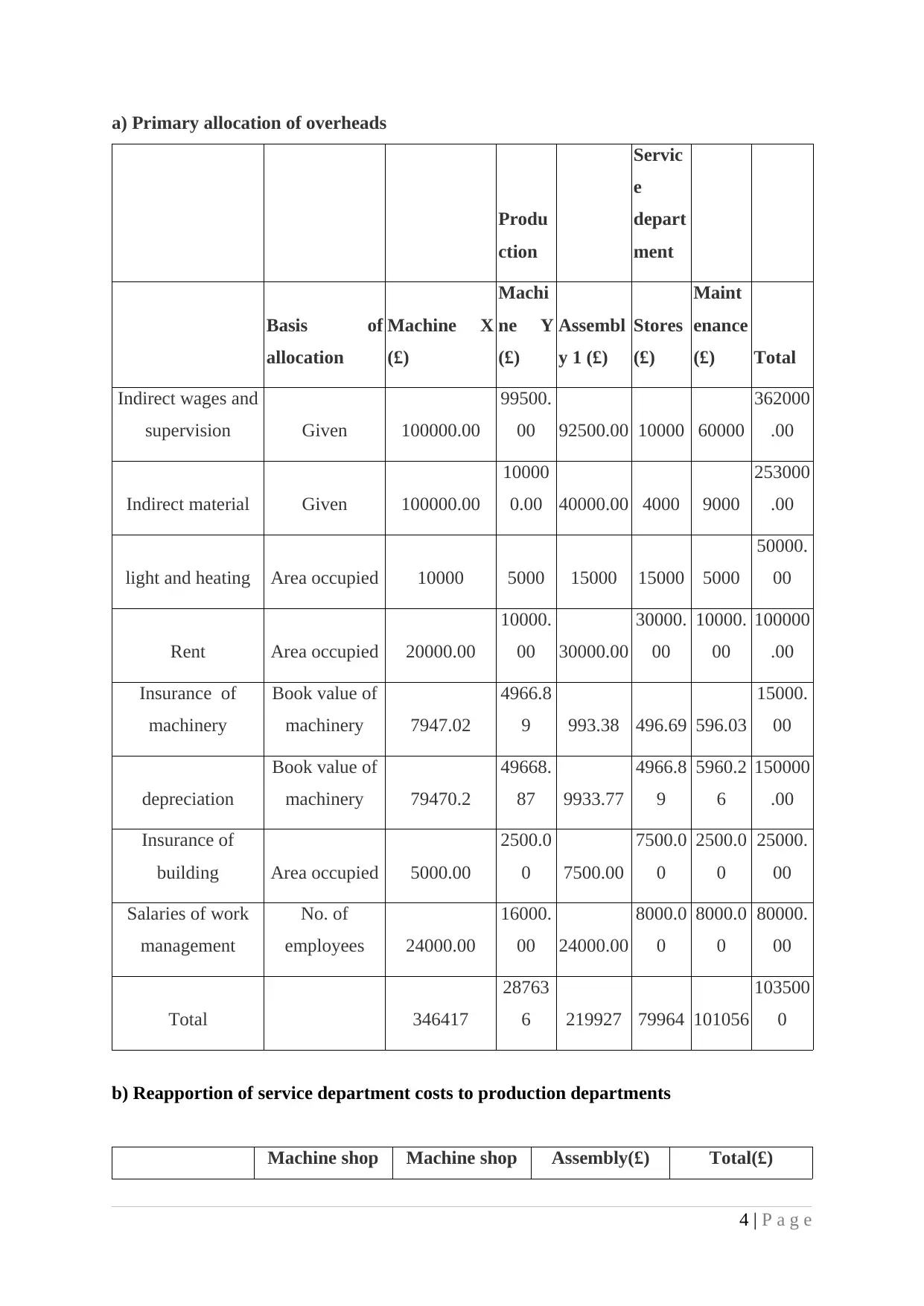
a) Primary allocation of overheads
Produ
ction
Servic
e
depart
ment
Basis of
allocation
Machine X
(£)
Machi
ne Y
(£)
Assembl
y 1 (£)
Stores
(£)
Maint
enance
(£) Total
Indirect wages and
supervision Given 100000.00
99500.
00 92500.00 10000 60000
362000
.00
Indirect material Given 100000.00
10000
0.00 40000.00 4000 9000
253000
.00
light and heating Area occupied 10000 5000 15000 15000 5000
50000.
00
Rent Area occupied 20000.00
10000.
00 30000.00
30000.
00
10000.
00
100000
.00
Insurance of
machinery
Book value of
machinery 7947.02
4966.8
9 993.38 496.69 596.03
15000.
00
depreciation
Book value of
machinery 79470.2
49668.
87 9933.77
4966.8
9
5960.2
6
150000
.00
Insurance of
building Area occupied 5000.00
2500.0
0 7500.00
7500.0
0
2500.0
0
25000.
00
Salaries of work
management
No. of
employees 24000.00
16000.
00 24000.00
8000.0
0
8000.0
0
80000.
00
Total 346417
28763
6 219927 79964 101056
103500
0
b) Reapportion of service department costs to production departments
Machine shop Machine shop Assembly(£) Total(£)
4 | P a g e
Produ
ction
Servic
e
depart
ment
Basis of
allocation
Machine X
(£)
Machi
ne Y
(£)
Assembl
y 1 (£)
Stores
(£)
Maint
enance
(£) Total
Indirect wages and
supervision Given 100000.00
99500.
00 92500.00 10000 60000
362000
.00
Indirect material Given 100000.00
10000
0.00 40000.00 4000 9000
253000
.00
light and heating Area occupied 10000 5000 15000 15000 5000
50000.
00
Rent Area occupied 20000.00
10000.
00 30000.00
30000.
00
10000.
00
100000
.00
Insurance of
machinery
Book value of
machinery 7947.02
4966.8
9 993.38 496.69 596.03
15000.
00
depreciation
Book value of
machinery 79470.2
49668.
87 9933.77
4966.8
9
5960.2
6
150000
.00
Insurance of
building Area occupied 5000.00
2500.0
0 7500.00
7500.0
0
2500.0
0
25000.
00
Salaries of work
management
No. of
employees 24000.00
16000.
00 24000.00
8000.0
0
8000.0
0
80000.
00
Total 346417
28763
6 219927 79964 101056
103500
0
b) Reapportion of service department costs to production departments
Machine shop Machine shop Assembly(£) Total(£)
4 | P a g e
⊘ This is a preview!⊘
Do you want full access?
Subscribe today to unlock all pages.

Trusted by 1+ million students worldwide
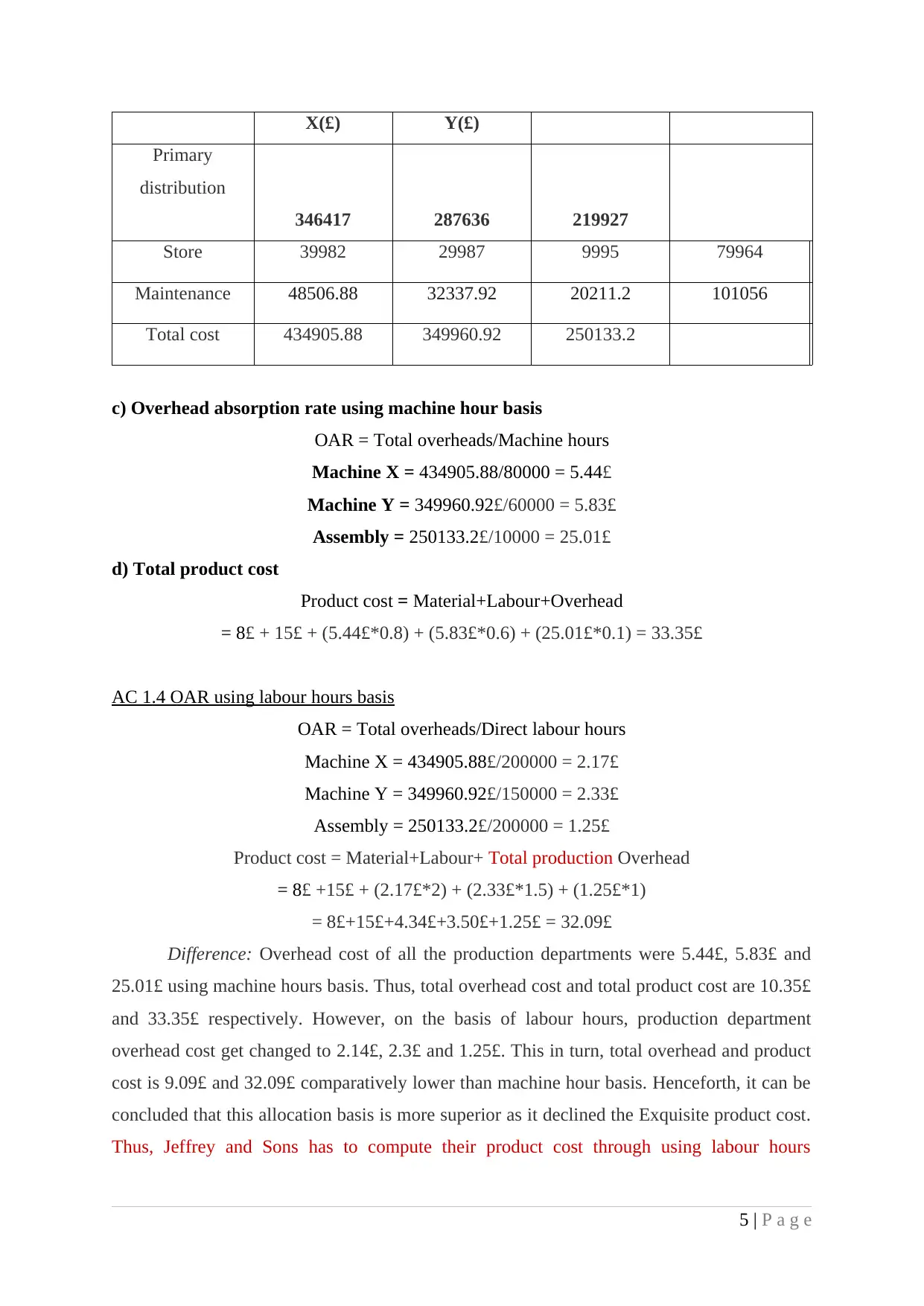
X(£) Y(£)
Primary
distribution
346417 287636 219927
Store 39982 29987 9995 79964
Maintenance 48506.88 32337.92 20211.2 101056
Total cost 434905.88 349960.92 250133.2
c) Overhead absorption rate using machine hour basis
OAR = Total overheads/Machine hours
Machine X = 434905.88/80000 = 5.44£
Machine Y = 349960.92£/60000 = 5.83£
Assembly = 250133.2£/10000 = 25.01£
d) Total product cost
Product cost = Material+Labour+Overhead
= 8£ + 15£ + (5.44£*0.8) + (5.83£*0.6) + (25.01£*0.1) = 33.35£
AC 1.4 OAR using labour hours basis
OAR = Total overheads/Direct labour hours
Machine X = 434905.88£/200000 = 2.17£
Machine Y = 349960.92£/150000 = 2.33£
Assembly = 250133.2£/200000 = 1.25£
Product cost = Material+Labour+ Total production Overhead
= 8£ +15£ + (2.17£*2) + (2.33£*1.5) + (1.25£*1)
= 8£+15£+4.34£+3.50£+1.25£ = 32.09£
Difference: Overhead cost of all the production departments were 5.44£, 5.83£ and
25.01£ using machine hours basis. Thus, total overhead cost and total product cost are 10.35£
and 33.35£ respectively. However, on the basis of labour hours, production department
overhead cost get changed to 2.14£, 2.3£ and 1.25£. This in turn, total overhead and product
cost is 9.09£ and 32.09£ comparatively lower than machine hour basis. Henceforth, it can be
concluded that this allocation basis is more superior as it declined the Exquisite product cost.
Thus, Jeffrey and Sons has to compute their product cost through using labour hours
5 | P a g e
Primary
distribution
346417 287636 219927
Store 39982 29987 9995 79964
Maintenance 48506.88 32337.92 20211.2 101056
Total cost 434905.88 349960.92 250133.2
c) Overhead absorption rate using machine hour basis
OAR = Total overheads/Machine hours
Machine X = 434905.88/80000 = 5.44£
Machine Y = 349960.92£/60000 = 5.83£
Assembly = 250133.2£/10000 = 25.01£
d) Total product cost
Product cost = Material+Labour+Overhead
= 8£ + 15£ + (5.44£*0.8) + (5.83£*0.6) + (25.01£*0.1) = 33.35£
AC 1.4 OAR using labour hours basis
OAR = Total overheads/Direct labour hours
Machine X = 434905.88£/200000 = 2.17£
Machine Y = 349960.92£/150000 = 2.33£
Assembly = 250133.2£/200000 = 1.25£
Product cost = Material+Labour+ Total production Overhead
= 8£ +15£ + (2.17£*2) + (2.33£*1.5) + (1.25£*1)
= 8£+15£+4.34£+3.50£+1.25£ = 32.09£
Difference: Overhead cost of all the production departments were 5.44£, 5.83£ and
25.01£ using machine hours basis. Thus, total overhead cost and total product cost are 10.35£
and 33.35£ respectively. However, on the basis of labour hours, production department
overhead cost get changed to 2.14£, 2.3£ and 1.25£. This in turn, total overhead and product
cost is 9.09£ and 32.09£ comparatively lower than machine hour basis. Henceforth, it can be
concluded that this allocation basis is more superior as it declined the Exquisite product cost.
Thus, Jeffrey and Sons has to compute their product cost through using labour hours
5 | P a g e
Paraphrase This Document
Need a fresh take? Get an instant paraphrase of this document with our AI Paraphraser
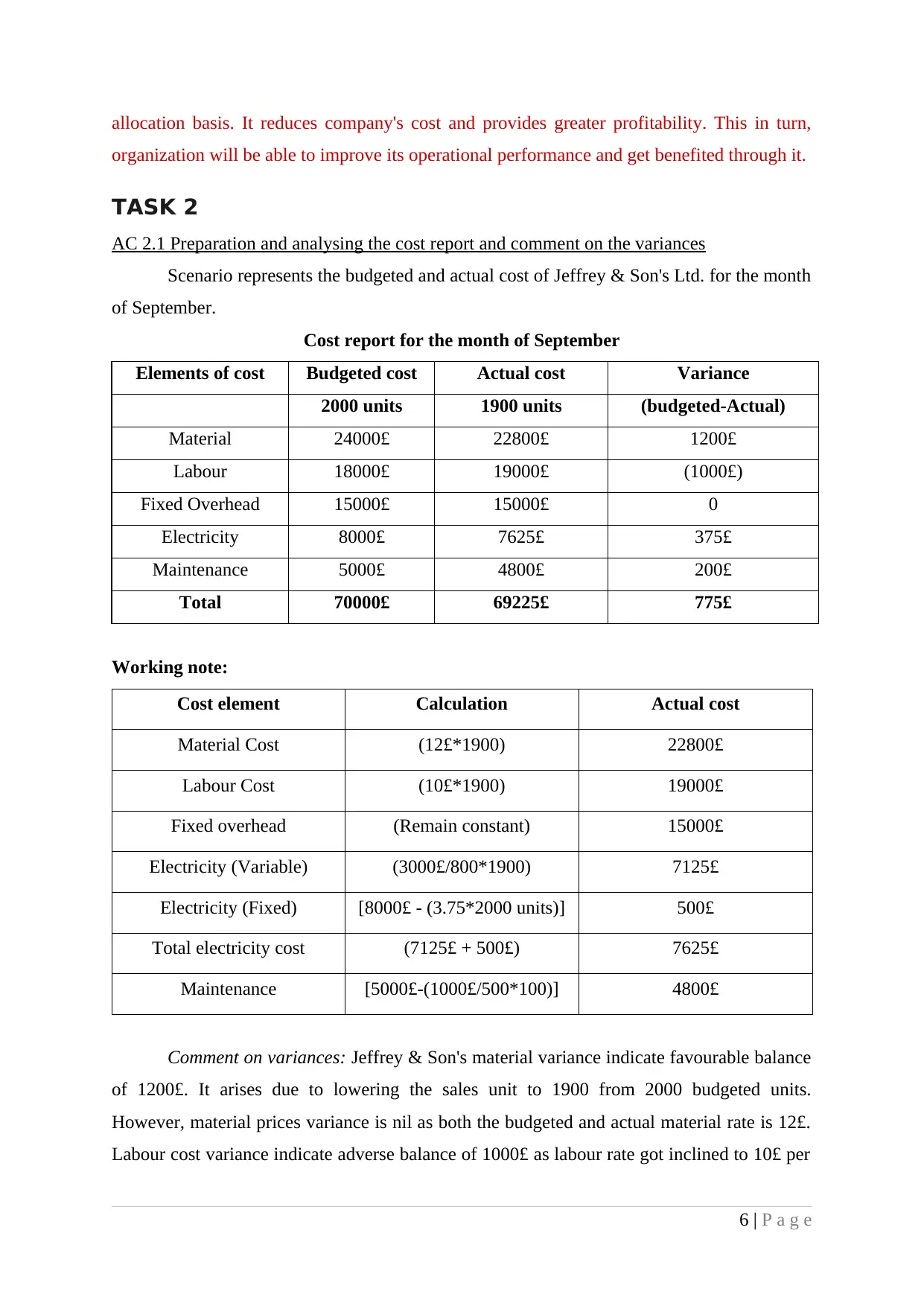
allocation basis. It reduces company's cost and provides greater profitability. This in turn,
organization will be able to improve its operational performance and get benefited through it.
TASK 2
AC 2.1 Preparation and analysing the cost report and comment on the variances
Scenario represents the budgeted and actual cost of Jeffrey & Son's Ltd. for the month
of September.
Cost report for the month of September
Elements of cost Budgeted cost Actual cost Variance
2000 units 1900 units (budgeted-Actual)
Material 24000£ 22800£ 1200£
Labour 18000£ 19000£ (1000£)
Fixed Overhead 15000£ 15000£ 0
Electricity 8000£ 7625£ 375£
Maintenance 5000£ 4800£ 200£
Total 70000£ 69225£ 775£
Working note:
Cost element Calculation Actual cost
Material Cost (12£*1900) 22800£
Labour Cost (10£*1900) 19000£
Fixed overhead (Remain constant) 15000£
Electricity (Variable) (3000£/800*1900) 7125£
Electricity (Fixed) [8000£ - (3.75*2000 units)] 500£
Total electricity cost (7125£ + 500£) 7625£
Maintenance [5000£-(1000£/500*100)] 4800£
Comment on variances: Jeffrey & Son's material variance indicate favourable balance
of 1200£. It arises due to lowering the sales unit to 1900 from 2000 budgeted units.
However, material prices variance is nil as both the budgeted and actual material rate is 12£.
Labour cost variance indicate adverse balance of 1000£ as labour rate got inclined to 10£ per
6 | P a g e
organization will be able to improve its operational performance and get benefited through it.
TASK 2
AC 2.1 Preparation and analysing the cost report and comment on the variances
Scenario represents the budgeted and actual cost of Jeffrey & Son's Ltd. for the month
of September.
Cost report for the month of September
Elements of cost Budgeted cost Actual cost Variance
2000 units 1900 units (budgeted-Actual)
Material 24000£ 22800£ 1200£
Labour 18000£ 19000£ (1000£)
Fixed Overhead 15000£ 15000£ 0
Electricity 8000£ 7625£ 375£
Maintenance 5000£ 4800£ 200£
Total 70000£ 69225£ 775£
Working note:
Cost element Calculation Actual cost
Material Cost (12£*1900) 22800£
Labour Cost (10£*1900) 19000£
Fixed overhead (Remain constant) 15000£
Electricity (Variable) (3000£/800*1900) 7125£
Electricity (Fixed) [8000£ - (3.75*2000 units)] 500£
Total electricity cost (7125£ + 500£) 7625£
Maintenance [5000£-(1000£/500*100)] 4800£
Comment on variances: Jeffrey & Son's material variance indicate favourable balance
of 1200£. It arises due to lowering the sales unit to 1900 from 2000 budgeted units.
However, material prices variance is nil as both the budgeted and actual material rate is 12£.
Labour cost variance indicate adverse balance of 1000£ as labour rate got inclined to 10£ per
6 | P a g e
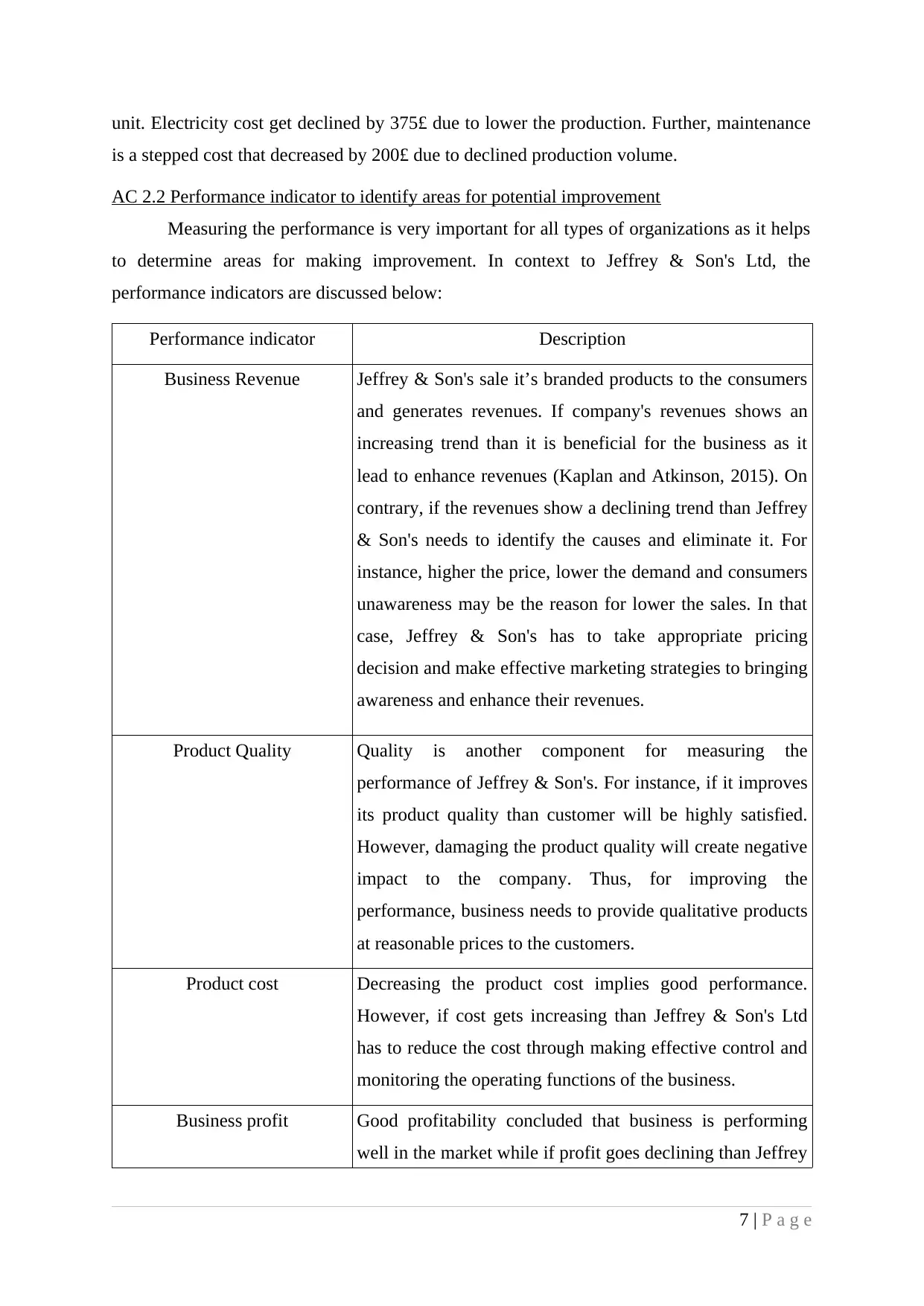
unit. Electricity cost get declined by 375£ due to lower the production. Further, maintenance
is a stepped cost that decreased by 200£ due to declined production volume.
AC 2.2 Performance indicator to identify areas for potential improvement
Measuring the performance is very important for all types of organizations as it helps
to determine areas for making improvement. In context to Jeffrey & Son's Ltd, the
performance indicators are discussed below:
Performance indicator Description
Business Revenue Jeffrey & Son's sale it’s branded products to the consumers
and generates revenues. If company's revenues shows an
increasing trend than it is beneficial for the business as it
lead to enhance revenues (Kaplan and Atkinson, 2015). On
contrary, if the revenues show a declining trend than Jeffrey
& Son's needs to identify the causes and eliminate it. For
instance, higher the price, lower the demand and consumers
unawareness may be the reason for lower the sales. In that
case, Jeffrey & Son's has to take appropriate pricing
decision and make effective marketing strategies to bringing
awareness and enhance their revenues.
Product Quality Quality is another component for measuring the
performance of Jeffrey & Son's. For instance, if it improves
its product quality than customer will be highly satisfied.
However, damaging the product quality will create negative
impact to the company. Thus, for improving the
performance, business needs to provide qualitative products
at reasonable prices to the customers.
Product cost Decreasing the product cost implies good performance.
However, if cost gets increasing than Jeffrey & Son's Ltd
has to reduce the cost through making effective control and
monitoring the operating functions of the business.
Business profit Good profitability concluded that business is performing
well in the market while if profit goes declining than Jeffrey
7 | P a g e
is a stepped cost that decreased by 200£ due to declined production volume.
AC 2.2 Performance indicator to identify areas for potential improvement
Measuring the performance is very important for all types of organizations as it helps
to determine areas for making improvement. In context to Jeffrey & Son's Ltd, the
performance indicators are discussed below:
Performance indicator Description
Business Revenue Jeffrey & Son's sale it’s branded products to the consumers
and generates revenues. If company's revenues shows an
increasing trend than it is beneficial for the business as it
lead to enhance revenues (Kaplan and Atkinson, 2015). On
contrary, if the revenues show a declining trend than Jeffrey
& Son's needs to identify the causes and eliminate it. For
instance, higher the price, lower the demand and consumers
unawareness may be the reason for lower the sales. In that
case, Jeffrey & Son's has to take appropriate pricing
decision and make effective marketing strategies to bringing
awareness and enhance their revenues.
Product Quality Quality is another component for measuring the
performance of Jeffrey & Son's. For instance, if it improves
its product quality than customer will be highly satisfied.
However, damaging the product quality will create negative
impact to the company. Thus, for improving the
performance, business needs to provide qualitative products
at reasonable prices to the customers.
Product cost Decreasing the product cost implies good performance.
However, if cost gets increasing than Jeffrey & Son's Ltd
has to reduce the cost through making effective control and
monitoring the operating functions of the business.
Business profit Good profitability concluded that business is performing
well in the market while if profit goes declining than Jeffrey
7 | P a g e
⊘ This is a preview!⊘
Do you want full access?
Subscribe today to unlock all pages.

Trusted by 1+ million students worldwide
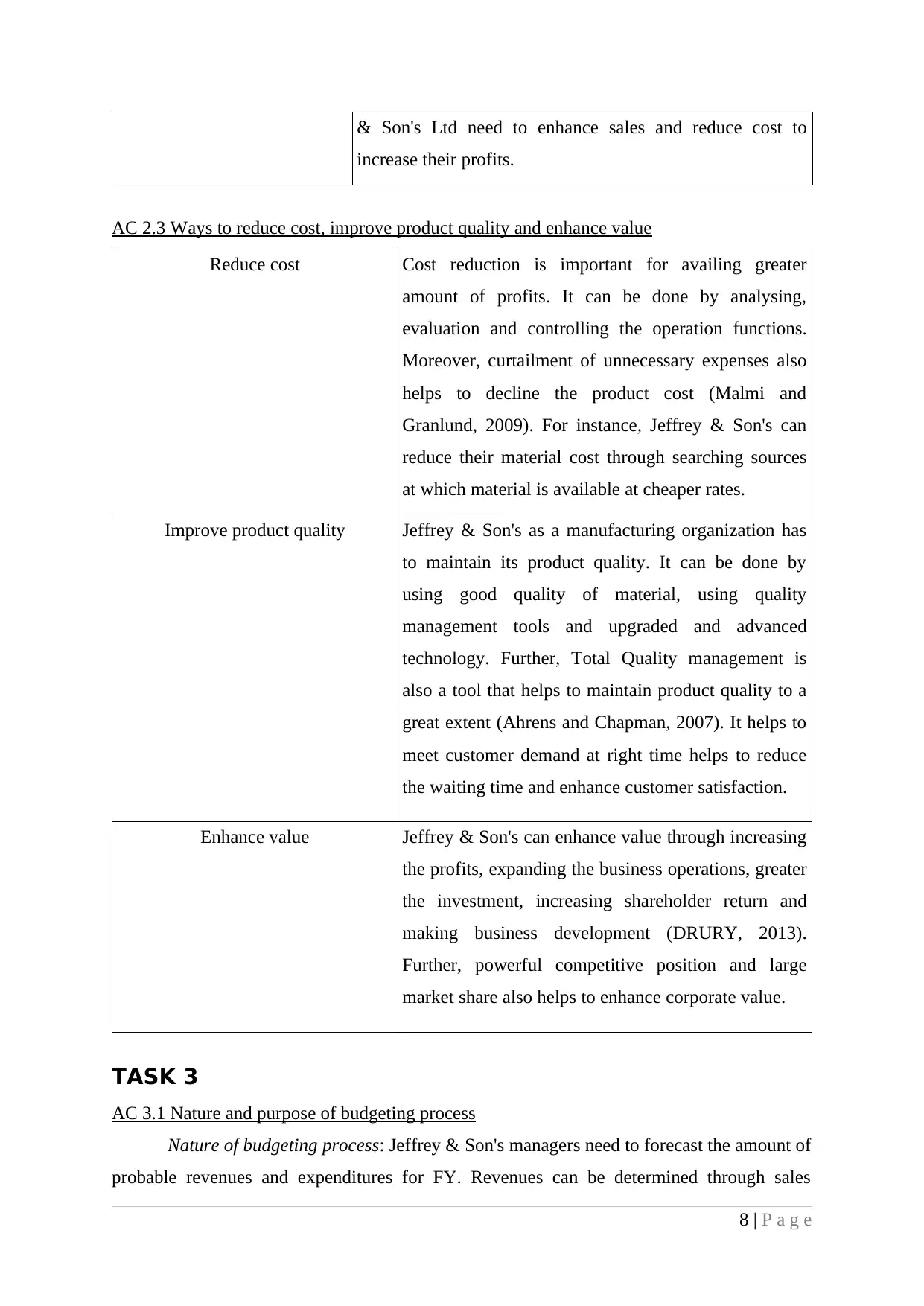
& Son's Ltd need to enhance sales and reduce cost to
increase their profits.
AC 2.3 Ways to reduce cost, improve product quality and enhance value
Reduce cost Cost reduction is important for availing greater
amount of profits. It can be done by analysing,
evaluation and controlling the operation functions.
Moreover, curtailment of unnecessary expenses also
helps to decline the product cost (Malmi and
Granlund, 2009). For instance, Jeffrey & Son's can
reduce their material cost through searching sources
at which material is available at cheaper rates.
Improve product quality Jeffrey & Son's as a manufacturing organization has
to maintain its product quality. It can be done by
using good quality of material, using quality
management tools and upgraded and advanced
technology. Further, Total Quality management is
also a tool that helps to maintain product quality to a
great extent (Ahrens and Chapman, 2007). It helps to
meet customer demand at right time helps to reduce
the waiting time and enhance customer satisfaction.
Enhance value Jeffrey & Son's can enhance value through increasing
the profits, expanding the business operations, greater
the investment, increasing shareholder return and
making business development (DRURY, 2013).
Further, powerful competitive position and large
market share also helps to enhance corporate value.
TASK 3
AC 3.1 Nature and purpose of budgeting process
Nature of budgeting process: Jeffrey & Son's managers need to forecast the amount of
probable revenues and expenditures for FY. Revenues can be determined through sales
8 | P a g e
increase their profits.
AC 2.3 Ways to reduce cost, improve product quality and enhance value
Reduce cost Cost reduction is important for availing greater
amount of profits. It can be done by analysing,
evaluation and controlling the operation functions.
Moreover, curtailment of unnecessary expenses also
helps to decline the product cost (Malmi and
Granlund, 2009). For instance, Jeffrey & Son's can
reduce their material cost through searching sources
at which material is available at cheaper rates.
Improve product quality Jeffrey & Son's as a manufacturing organization has
to maintain its product quality. It can be done by
using good quality of material, using quality
management tools and upgraded and advanced
technology. Further, Total Quality management is
also a tool that helps to maintain product quality to a
great extent (Ahrens and Chapman, 2007). It helps to
meet customer demand at right time helps to reduce
the waiting time and enhance customer satisfaction.
Enhance value Jeffrey & Son's can enhance value through increasing
the profits, expanding the business operations, greater
the investment, increasing shareholder return and
making business development (DRURY, 2013).
Further, powerful competitive position and large
market share also helps to enhance corporate value.
TASK 3
AC 3.1 Nature and purpose of budgeting process
Nature of budgeting process: Jeffrey & Son's managers need to forecast the amount of
probable revenues and expenditures for FY. Revenues can be determined through sales
8 | P a g e
Paraphrase This Document
Need a fresh take? Get an instant paraphrase of this document with our AI Paraphraser
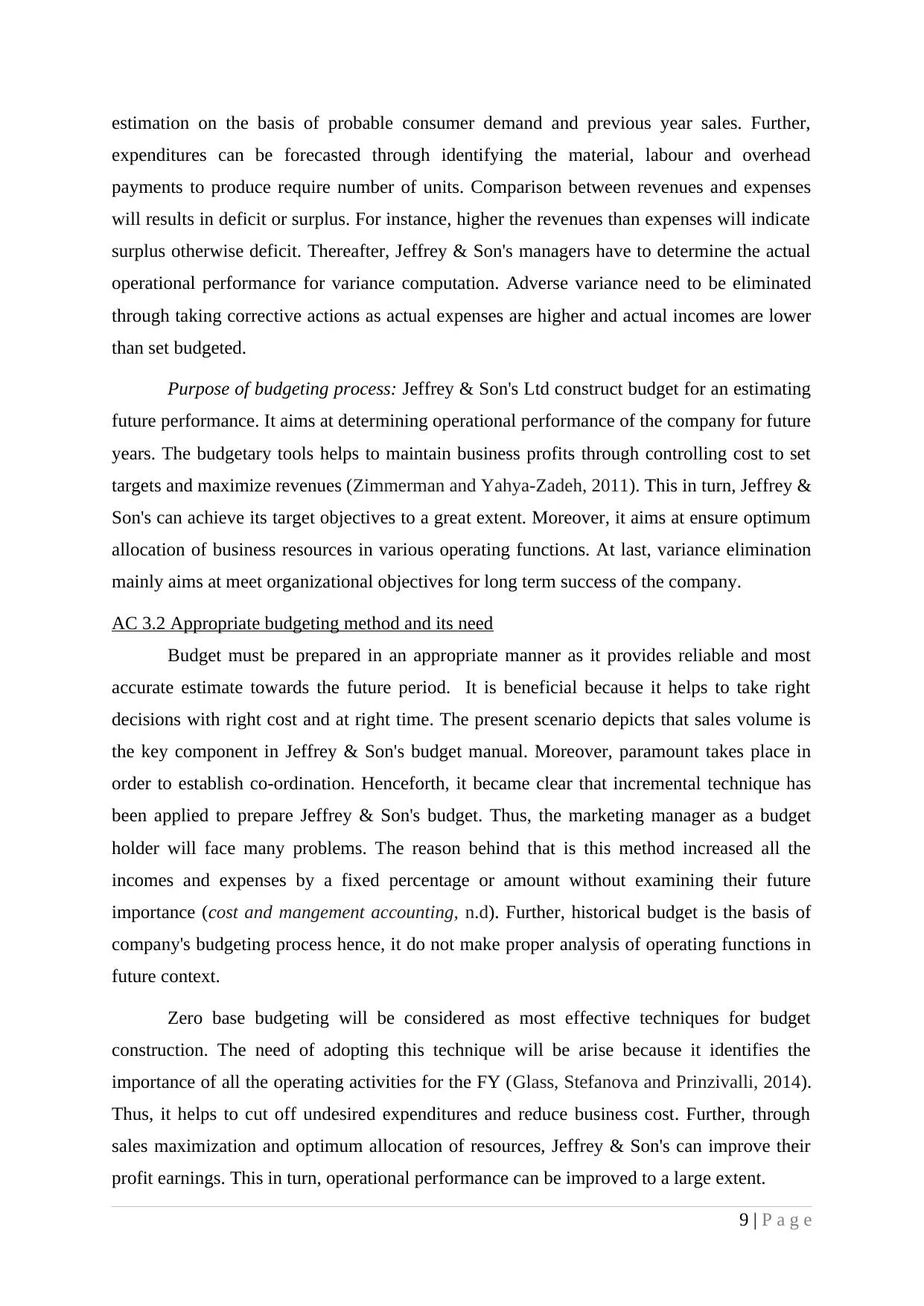
estimation on the basis of probable consumer demand and previous year sales. Further,
expenditures can be forecasted through identifying the material, labour and overhead
payments to produce require number of units. Comparison between revenues and expenses
will results in deficit or surplus. For instance, higher the revenues than expenses will indicate
surplus otherwise deficit. Thereafter, Jeffrey & Son's managers have to determine the actual
operational performance for variance computation. Adverse variance need to be eliminated
through taking corrective actions as actual expenses are higher and actual incomes are lower
than set budgeted.
Purpose of budgeting process: Jeffrey & Son's Ltd construct budget for an estimating
future performance. It aims at determining operational performance of the company for future
years. The budgetary tools helps to maintain business profits through controlling cost to set
targets and maximize revenues (Zimmerman and Yahya-Zadeh, 2011). This in turn, Jeffrey &
Son's can achieve its target objectives to a great extent. Moreover, it aims at ensure optimum
allocation of business resources in various operating functions. At last, variance elimination
mainly aims at meet organizational objectives for long term success of the company.
AC 3.2 Appropriate budgeting method and its need
Budget must be prepared in an appropriate manner as it provides reliable and most
accurate estimate towards the future period. It is beneficial because it helps to take right
decisions with right cost and at right time. The present scenario depicts that sales volume is
the key component in Jeffrey & Son's budget manual. Moreover, paramount takes place in
order to establish co-ordination. Henceforth, it became clear that incremental technique has
been applied to prepare Jeffrey & Son's budget. Thus, the marketing manager as a budget
holder will face many problems. The reason behind that is this method increased all the
incomes and expenses by a fixed percentage or amount without examining their future
importance (cost and mangement accounting, n.d). Further, historical budget is the basis of
company's budgeting process hence, it do not make proper analysis of operating functions in
future context.
Zero base budgeting will be considered as most effective techniques for budget
construction. The need of adopting this technique will be arise because it identifies the
importance of all the operating activities for the FY (Glass, Stefanova and Prinzivalli, 2014).
Thus, it helps to cut off undesired expenditures and reduce business cost. Further, through
sales maximization and optimum allocation of resources, Jeffrey & Son's can improve their
profit earnings. This in turn, operational performance can be improved to a large extent.
9 | P a g e
expenditures can be forecasted through identifying the material, labour and overhead
payments to produce require number of units. Comparison between revenues and expenses
will results in deficit or surplus. For instance, higher the revenues than expenses will indicate
surplus otherwise deficit. Thereafter, Jeffrey & Son's managers have to determine the actual
operational performance for variance computation. Adverse variance need to be eliminated
through taking corrective actions as actual expenses are higher and actual incomes are lower
than set budgeted.
Purpose of budgeting process: Jeffrey & Son's Ltd construct budget for an estimating
future performance. It aims at determining operational performance of the company for future
years. The budgetary tools helps to maintain business profits through controlling cost to set
targets and maximize revenues (Zimmerman and Yahya-Zadeh, 2011). This in turn, Jeffrey &
Son's can achieve its target objectives to a great extent. Moreover, it aims at ensure optimum
allocation of business resources in various operating functions. At last, variance elimination
mainly aims at meet organizational objectives for long term success of the company.
AC 3.2 Appropriate budgeting method and its need
Budget must be prepared in an appropriate manner as it provides reliable and most
accurate estimate towards the future period. It is beneficial because it helps to take right
decisions with right cost and at right time. The present scenario depicts that sales volume is
the key component in Jeffrey & Son's budget manual. Moreover, paramount takes place in
order to establish co-ordination. Henceforth, it became clear that incremental technique has
been applied to prepare Jeffrey & Son's budget. Thus, the marketing manager as a budget
holder will face many problems. The reason behind that is this method increased all the
incomes and expenses by a fixed percentage or amount without examining their future
importance (cost and mangement accounting, n.d). Further, historical budget is the basis of
company's budgeting process hence, it do not make proper analysis of operating functions in
future context.
Zero base budgeting will be considered as most effective techniques for budget
construction. The need of adopting this technique will be arise because it identifies the
importance of all the operating activities for the FY (Glass, Stefanova and Prinzivalli, 2014).
Thus, it helps to cut off undesired expenditures and reduce business cost. Further, through
sales maximization and optimum allocation of resources, Jeffrey & Son's can improve their
profit earnings. This in turn, operational performance can be improved to a large extent.
9 | P a g e
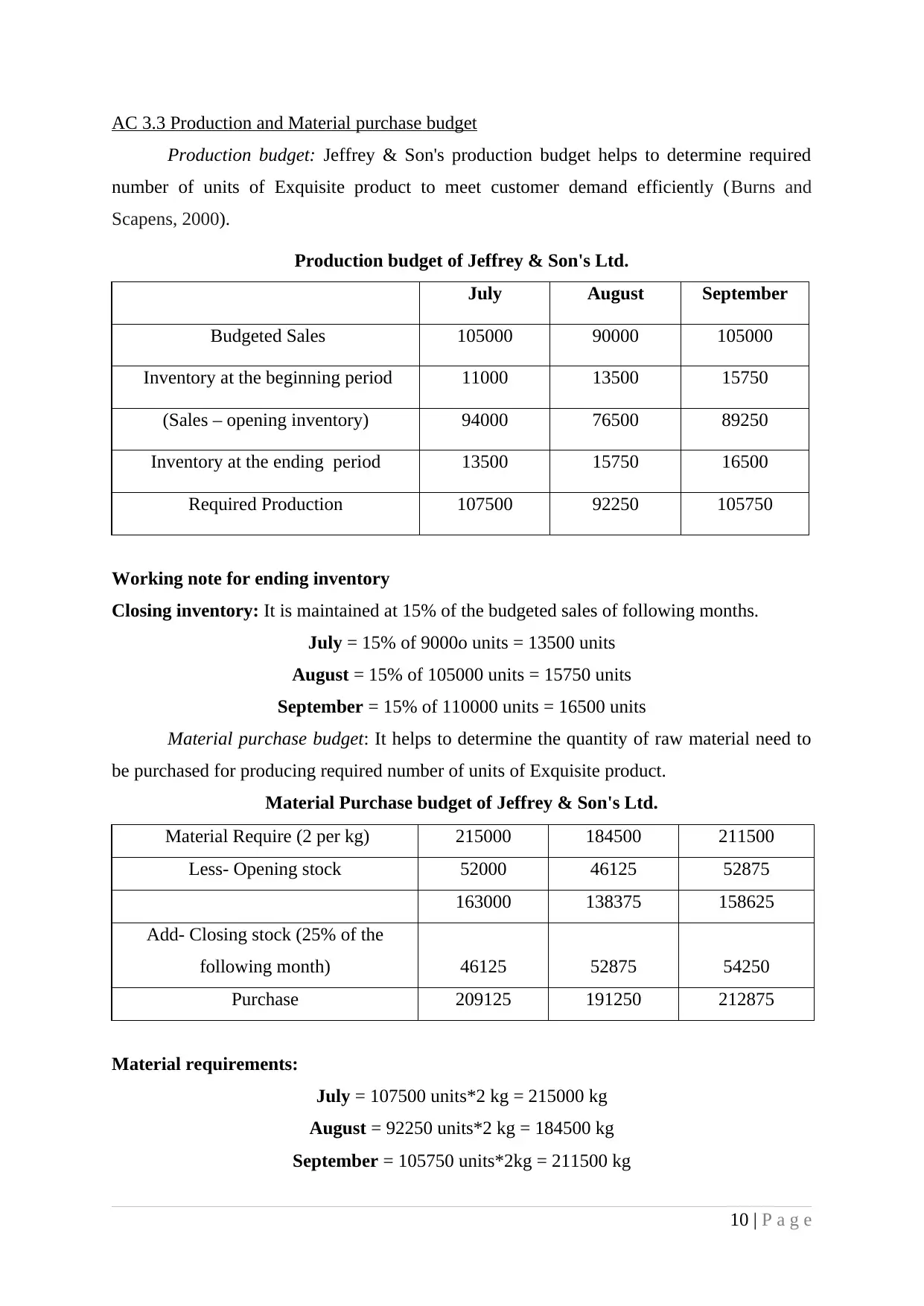
AC 3.3 Production and Material purchase budget
Production budget: Jeffrey & Son's production budget helps to determine required
number of units of Exquisite product to meet customer demand efficiently (Burns and
Scapens, 2000).
Production budget of Jeffrey & Son's Ltd.
July August September
Budgeted Sales 105000 90000 105000
Inventory at the beginning period 11000 13500 15750
(Sales – opening inventory) 94000 76500 89250
Inventory at the ending period 13500 15750 16500
Required Production 107500 92250 105750
Working note for ending inventory
Closing inventory: It is maintained at 15% of the budgeted sales of following months.
July = 15% of 9000o units = 13500 units
August = 15% of 105000 units = 15750 units
September = 15% of 110000 units = 16500 units
Material purchase budget: It helps to determine the quantity of raw material need to
be purchased for producing required number of units of Exquisite product.
Material Purchase budget of Jeffrey & Son's Ltd.
Material Require (2 per kg) 215000 184500 211500
Less- Opening stock 52000 46125 52875
163000 138375 158625
Add- Closing stock (25% of the
following month) 46125 52875 54250
Purchase 209125 191250 212875
Material requirements:
July = 107500 units*2 kg = 215000 kg
August = 92250 units*2 kg = 184500 kg
September = 105750 units*2kg = 211500 kg
10 | P a g e
Production budget: Jeffrey & Son's production budget helps to determine required
number of units of Exquisite product to meet customer demand efficiently (Burns and
Scapens, 2000).
Production budget of Jeffrey & Son's Ltd.
July August September
Budgeted Sales 105000 90000 105000
Inventory at the beginning period 11000 13500 15750
(Sales – opening inventory) 94000 76500 89250
Inventory at the ending period 13500 15750 16500
Required Production 107500 92250 105750
Working note for ending inventory
Closing inventory: It is maintained at 15% of the budgeted sales of following months.
July = 15% of 9000o units = 13500 units
August = 15% of 105000 units = 15750 units
September = 15% of 110000 units = 16500 units
Material purchase budget: It helps to determine the quantity of raw material need to
be purchased for producing required number of units of Exquisite product.
Material Purchase budget of Jeffrey & Son's Ltd.
Material Require (2 per kg) 215000 184500 211500
Less- Opening stock 52000 46125 52875
163000 138375 158625
Add- Closing stock (25% of the
following month) 46125 52875 54250
Purchase 209125 191250 212875
Material requirements:
July = 107500 units*2 kg = 215000 kg
August = 92250 units*2 kg = 184500 kg
September = 105750 units*2kg = 211500 kg
10 | P a g e
⊘ This is a preview!⊘
Do you want full access?
Subscribe today to unlock all pages.

Trusted by 1+ million students worldwide
1 out of 18
Related Documents
Your All-in-One AI-Powered Toolkit for Academic Success.
+13062052269
info@desklib.com
Available 24*7 on WhatsApp / Email
![[object Object]](/_next/static/media/star-bottom.7253800d.svg)
Unlock your academic potential
Copyright © 2020–2025 A2Z Services. All Rights Reserved. Developed and managed by ZUCOL.





